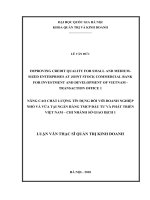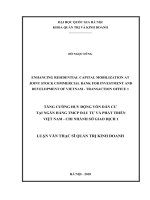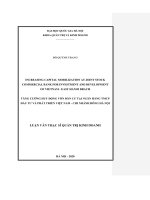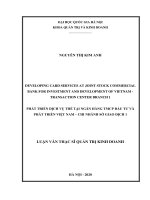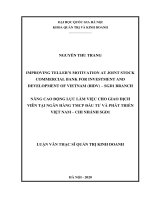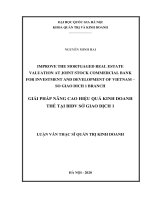Development of consumer loan at joint stock commercial bank for investment and development of viet nam – bien hoa branch
Bạn đang xem bản rút gọn của tài liệu. Xem và tải ngay bản đầy đủ của tài liệu tại đây (1.4 MB, 80 trang )
STATE BANK OF VIETNAM MINISTRY OF EDUCATION & TRAINING
HO CHI MINH UNIVERSITY OF BANKING
HO CHI MINH
UNIVERSITY OF BANKING
NGUYEN TRAN THAO UYEN
DEVELOPMENT OF CONSUMER LOAN AT JOINT STOCK
COMMERCIAL BANK FOR INVESTMENT AND DEVELOPMENT
OF VIET NAM – BIEN HOA BRANCH
GRADUATION THESIS
THE MAJOR: FINANCE AND BANKING
CODE: 7 34 02 01
HO CHI MINH CITY, 2022
ii
STATE BANK OF VIETNAM MINISTRY OF EDUCATION &TRAINING
HO CHI MINH UNIVERSITY OF BANKING
STUDENT: NGUYEN TRAN THAO UYEN
STUDENT ID: 050607190627
CLASS: HQ7-GE18
DEVELOPMENT OF CONSUMER LOAN AT JOINT STOCK
COMMERCIAL BANK FOR INVESTMENT AND DEVELOPMENT
OF VIET NAM – BIEN HOA BRANCH
GRADUATION THESIS
THE MAJOR: FINANCE AND BANKING
CODE: 7 34 02 01
SUPERVISOR
Associate Prf. Dr. HOANG THI THANH HANG
HO CHI MINH CITY, 2022
iii
ABSTRACT
Vietnam entered the middle income stage. The consumption activities of society are
increasing and the demand for consumer loans also increases. Consumer loan
activities are growing strongly in recent years. Although on the progress of
development, but on the bank's side, there are still some shortcomings affecting the
development of consumer loan. Therefore, it is necessary to have solutions to develop
consumer loans to ensure stable and sustainable growth. The research objective is to
analyze the current situation of consumer loan activities at BIDV- Bien Hoa branch.
From there, propose solutions to develop consumer loan activities at BIDV- Bien Hoa
branch. To achieve the set research objectives, the study mainly uses qualitative
research methods. Research results: the study has systematized the factors affecting
the development of consumer loan such as: environmental factors such as economic,
social, cultural, system policies and economic programs of the state. Factors from
customers include: legal capacity, credibility, collateral and financial ability of the
customer. Subjective factors affecting the development of consumer loans include:
Professional ethics of staff, techniques, procedures and process of application
appraisal. Consumer loan has seen growth in the number of customers, loan
outstanding balance and control of the bad debt ratio. Conclusion and implication:
Some shortcomings in the development of consumer loans at BIDV Bien Hoa branch
such as: unstable growth, undiversified products, low balance of outstanding loans,
bad debt ratio high in the bad debt structure of the bank. The author also proposes
some solutions to develop consumer loans at BIDV- Bien Hoa branch in the coming
time.
Keywords: consumer loan, commercial bank, BIDV.
iv
ACKNOWLEDGMENT
First of all, I would like to express my deepest gratitude to the teachers of Banking
University. Especially, I would like to thank my supervisor Associate Prf. Dr. Hoang
Thi Thanh Hang, who directly guided and imparted knowledge to me and helped me
a lot during the process of writing this thesis.
Besides, to be able to complete this thesis, it is impossible not to mention the great
support from the bank, Mr./Ms., individual customers at BIDV- Bien Hoa branch has
created favorable conditions, provided data to help me more convenient in survey and
evaluation.
I would also like to express my sincere thanks to my family and friends who have
encouraged and supported me throughout the process of studying and writing this
thesis.
Perhaps knowledge is infinite, but each person's acquisition of knowledge always has
certain limitations, so in the thesis it is inevitable that limitations and shortcomings
can be avoided. Sincerely hope to receive your sincere suggestions for the thesis to
achieve the best results.
Finally, I would like to wish the teachers of the Faculty of Finance and Banking,
Banking University of Ho Chi Minh City have health, happiness, success on her
teaching path. Wishing the leadership, brothers/sisters, customers at BIDV- Bien Hoa
Branch, more success in their work. We wish you more prosperity in the future.
Sincerely,
v
COMMITMENT
I hereby declare that this is the research work: "Development of consumer Loan at
Joint Stock Commercial Bank for Investment and Development of Viet Nam - Bien
Hoa branch". This is a post made by me under the guidance of Associate Prf. Dr.
Hoang Thi Thanh Hang. The content and research of this topic is honest and has not
been published in any way. In this report, there are references to some documents of
clear origin under the guidance of teachers of Faculty of Finance – Banking at
Banking University. The data in the tables of analysis, comments and reviews have
been collected by the author himself from various sources and are clearly shown in
the reference list.
Student’s Signature
Nguyen Tran Thao Uyen
vi
TABLE OF CONTENT
ABSTRACT ............................................................................................................. iii
ACKNOWLEDGMENT..........................................................................................iv
COMMITMENT ....................................................................................................... v
LIST OF ABBREVIATIONS................................................................................... x
LIST OF DIAGRAMS, TABLES AND FIGURES...............................................xi
INTRODUCTION .................................................................................................. vii
1.
Rationale ..................................................................................................... vii
2.
Research Objectives .................................................................................. viii
3.
Research Questions.................................................................................... viii
4.
The Scope of research...................................................................................ix
5.
Literature review...........................................................................................ix
6.
Research method......................................................................................... xii
CHAPTER 1: THE THEORY OF DEVELOPING CONSUMER LOAN AT
COMMERCIAL BANKS. ........................................................................................ 1
1.1. Consumer loan activities of commercial banks ............................................. 1
1.1.1.
The concept of consumer loan .......................................................... 1
1.1.2.
Characteristics of consumer loan ...................................................... 2
1.1.3.
Classification of consumer loan ........................................................ 3
1.1.3.1.
Based on the loan purpose ......................................................... 3
1.1.3.2.
Based on the form of loan security ............................................ 4
1.1.3.3.
Based on the repayment method ................................................ 4
1.1.3.4.
Based on the form of loan .......................................................... 4
1.2. Developing consumer loan activities of commercial banks .......................... 8
vii
1.2.1.
The concept of development consumer loan activities of
commercial banks................................................................................................ 8
1.2.2.
Criteria for evaluating the development of consumer loan activities
of commercial banks ........................................................................................... 9
1.2.2.1. Market share growth of consumer loan activities at commercial
banks
…………………………………………………………………….9
1.2.2.2. Loan outstanding balance at commercial banks................................ 9
1.2.2.3. Non-performing consumer loan at commercial banks .................... 10
1.2.2.4. The profit of consumer loan at commercial banks .......................... 12
1.2.3.
The experiences in development consumer loan activities of
commercial banks and the lessons for BIDV- Bien Hoa branch ...................... 12
1.2.3.1.
Vietnam Bank for Agriculture and Rural Development
(Agribank) ................................................................................................. 12
1.2.3.2.
Vietnam Prosperity Joint Stock Commercial Bank (VPBank) 13
1.2.3.3.
The lessons for BIDV- Bien Hoa branch ................................. 14
SUMMARY OF THE CHAPTER 1 ...................................................................... 16
CHAPTER 2: THE SITUATION OF DEVELOPING CONSUMER LOAN
ACTIVITIES
AT
JOINT
STOCK
COMMERCIAL
BANK
FOR
INVESTMENT AND DEVELOPMENT OF VIETNAM - BIEN HOA
BRANCH. ................................................................................................................ 17
2.1. Overview of Joint Stock Commercial Bank for Investment and
Development of Vietnam ...................................................................................... 17
2.1.1.
History of the establishment and development of the Joint Stock
Commercial Bank for Investment and Development of Vietnam. ................... 17
2.1.2.
Functions and tasks of Joint Stock Commercial Bank for
Investment and Development of Vietnam – Bien Hoa branch. ........................ 19
viii
2.1.3.
Functions and tasks of Joint Stock Commercial Bank for
Investment and Development of Vietnam – Bien Hoa branch. ........................ 20
2.1.4.
Performance of Joint Stock Commercial Bank for Investment and
Development of Vietnam – Bien Hoa branch. .................................................. 23
2.2. The situation of developing consumer loan activities at Joint Stock
Commercial Bank for Investment and Development of Vietnam – Bien Hoa
branch. ................................................................................................................... 31
2.2.1. Market share growth of consumer loan activities at BIDV - Bien Hoa
branch. ............................................................................................................... 33
2.2.2. Loan outstanding balance growth at Joint Stock Commercial Bank for
Investment and Development of Vietnam – Bien Hoa branch. ........................ 36
2.2.3.
Non-performing consumer loans at Joint Stock Commercial Bank
for Investment and Development of Vietnam – Bien Hoa branch.................... 38
2.2.4.
The profit of loan at Joint Stock Commercial Bank for Investment
and Development of Vietnam – Bien Hoa branch ............................................ 40
2.3. Evaluating the results of the situation of consumer loan activities at Joint
Stock Commercial Bank for Investment and Development of Vietnam – Bien
Hoa branch ............................................................................................................ 42
2.3.1. The results ............................................................................................... 42
2.3.2. The limitations and the cause in consumer loan activities at Joint Stock
Commercial Bank for Investment and Development of Vietnam – Bien Hoa
branch ................................................................................................................ 43
2.3.2.1 The limitations .............................................................................. 43
2.3.2.2. The causes .................................................................................... 43
SUMMARY OF THE CHAPTER 2 ...................................................................... 47
CHAPTER 3: SOLUTIONS TO DEVELOP CONSUMER LOAN ACTIVITIES
AT JOINT STOCK COMMERCIAL BANK FOR INVESTMENT AND
ix
DEVELOPMENT OF VIETNAM. ....................................................................... 48
3.1. The orientation at Joint Stock Commercial Bank for Investment and
Development of Vietnam – Bien Hoa branch ....................................................... 48
3.1.1.
The general orientation at Joint Stock Commercial Bank for
Investment and Development of Vietnam – Bien Hoa branch ......................... 48
3.1.2.
The general orientation in developing consumer loan activities at
Joint Stock Commercial Bank for Investment and Development of Vietnam –
Bien Hoa Branch ............................................................................................... 49
3.2. Some solutions to develop consumer loan activities at Joint Stock
Commercial Bank for Investment and Development of Vietnam – Bien Hoa
branch .................................................................................................................... 49
3.2.1.
Promoting and advertising the consumer loan segment for BIDV -
Bien Hoa branch ................................................................................................ 49
3.2.2.
Improving the process and the quality of consumer loan services . 50
3.2.3.
Regarding the issue of receiving collateral and valuing the secured
assets
…………………………………………………………………….51
3.2.4.
Diversifing consumer loan products and link with strategic partners
…………………………………………………………………….52
3.2.5.
Strengthening the control of consumer loan risks ........................... 53
3.2.6.
Strengthening inspection and supervision of customers' use of loans
and sources of debt repayment .......................................................................... 54
3.2.7.
Improving the quality of human resources...................................... 56
3.3. Recommendation for Joint Stock Commercial Bank for Investment and
Development of Vietnam – Bien Hoa branch ....................................................... 57
SUMMARY OF THE CHAPTER 3 ...................................................................... 59
CONCLUSION ........................................................................................................ 60
REFERENCES ........................................................................................................ 61
x
LIST OF ABBREVIATIONS
BIDV
VP BANK
Joint Stock Commercial Bank for Investment and Development
of Vietnam
Vietnam prosperity joint stock commercial bank
VND
Vietnamdong
ATM
Automatic teller machine
AGRIBANK
Vietnam Bank for Agriculture and Rural Development
xi
LIST OF DIAGRAMS, TABLES AND FIGURES
DIAGRAMS
Diagram 1.1: Direct loan structure.
Diagram 1.2: Indirect consumer loan structure.
Diagram 2.1: BIDV - Bien Hoa branch’s Organizational structure.
TABLES
Table 2.1: Business results of BIDV – Bien Hoa branch from 2017 to 2021.
Table 2.2: The result of consumer loan at BIDV - Bien Hoa branch 2017-2021.
Table 2.3: The result of consumer loan activities at BIDV - Bien Hoa branch 20172021 according to purposing of using capital.
FIGURES
Figure 2.1: Outstanding loan balance growth ratio at BIDV-Bien Hoa branch 20172021.
Figure 2.1: Outstanding loan balance growth ratio at BIDV-Bien Hoa branch.
Figure 2.3: Outstanding loan balance structure of retail customers at BIDV - Bien
Hoa branch.
Figure 2.4: Non-performing loan at BIDV - Bien Hoa branch 2017-2021.
Figure 2.5: Non-performing loan ratio at BIDV - Bien Hoa branch 2017-2021.
Figure 2.6: Business operating expense structure at BIDV - Bien Hoa branch 20172021.
Figure 2.7: Business operating profit at BIDV - Bien Hoa branch 2017-2021.
Figure 2.8: Business operating profit at BIDV - Bien Hoa branch 2017 – 2021.
Figure 2.9: Business operating profit growth at BIDV - Bien Hoa branch 2017-2021.
Figure 2.10: Market share growth of consumer loan activities at BIDV - Bien Hoa
branch.
xii
Figure 2.11: Customer growth of consumer loan according to purposing of using
capital.
Figure 2.12: Outstanding consumer loan balance growth at BIDV - Bien Hoa branch
2017-2021.
Figure 2.13: outstanding loan balance growth of consumer loan according to
purposing of using capital.
Figure 2.14: Non-performing loan structure according to purposing of using.
Figure 2.15: Profit's growth at BIDV - Bien Hoa branch 2017-2021.
Figure 2.16: Profit's growth according to purposing of capital loan at BIDV - Bien
Hoa branch 2017-2021.
vii
INTRODUCTION
1.
Rationale
In integration, people’s living standards are also increasingly improved. In addition
to basic needs such as food, clothing and accommodation, the needs for material and
spiritual life are also being raised more and more such as a more beautiful and
comfortable home, better means of transports, travel more, etc. Therefore, people’s
demand for borrowing money for consumption also grow rapidly. This has created
better opportunities for commercial banks in consumer loan. Consumer loan plays a
vital role in improving the quality of life and the level of financial access for people,
contributing to the stability and development of the country’s economy. Vietnam is
considered as a potential market of consumer finance with ideal conditions such as
the development stage of economy, the scale of population is large with a high
proportion of working. Tendency to expand domestic consumption and increase
income levels of population which are favorable conditions to boost Vietnamese
consumer loan market will continue to develop effectively in the future.
Grasping the demand and also joining the same trend, over the years, the unit has
continuously promoted outstanding loan, consumer use gradually improving the loan
process as well as ensuring credit safety. However, the loan policies, regulations and
processes are still inadequate and have not been changed in time to meet the needs of
customers. Thereby, the credit growth of the unit in recent years is not really good.
Therefore, for these reasons, it is very practical to research and come up with solution
to overcome the restrictions in order to promote the growth of consumer credit at the
unit in a scientific manner. With that desire, I chose the topic “Development of
consumer loan at Joint Stock Commercial Bank for Investment and Development
Vietnam – Bien Hoa branch” to conduct my research for the thesis.
Keeping up with the development trend of banking products and services, consumer
loan at BIDV - Bien Hoa branch was also developed. The goal of this thesis is to
evaluate the situation in the consumer loan in this branch, based on the system of
evaluation indicators for consumer loan and the factors (subjective and objective)
affect to consumer loan of commercial banks. Based on the theoretical basis and the
viii
data collected from the branch, the author reviewed that consumer loan at BIDV –
Bien Hoa branch had significant developments both in outstanding loan, the number
of customers and performance. However, the consumer loan of the branch has not
really matched with its potentials and advantages. In addition, there are some
challenges of consumer loan in BIDV Bien Hoa which are need to exploit and deal
with in order to effectively recommendations and solutions for BIDV- Bien Hoa
branch to exploit their full potentials and strengths. As a result, this branch can expand
business activities, minimize risks and increase profitability in business operations.
2.
Research Objectives
a. General objective
Analysing of the situation of development of consumer loan at Joint Stock
Commercial Bank for Investment and Development of Vietnam-Bien Hoa branch,
thereby the author proposes some solutions, recommendations to enhance consumer
loan at BIDV -Bien Hoa branch.
b. Specific objectives
- Analysing the situation of development at BIDV –Bien Hoa branch.
- Propose some solutions to contribute to the development of consumer loan at
Joint Stock Commercial Bank for Investment and Development of Vietnam Bien Hoa branch.
3.
Research Questions
To achieve the research objectives, the author has raised the following research
questions as a basis for the implementation and implementation of the steps to carry
out the thesis, including:
The first research question: Which criteria affect on developing consumer loan
activities at Joint Stock Commercial Bank for Investment and Development – Bien
Hoa branch?
The second research question: How is the current status of consumer loan activities
at Joint Stock Commercial Bank for Investment and Development – Bien Hoa
branch?
ix
The third question: Which solutions should be implemented and carry out to complete
and develop consumer loan activities at Joint Stock Commercial Bank for Investment
and Development – Bien Hoa branch?
4.
The Scope of research
The study scope: Develop consumer loan activities at Joint Stock Commercial Bank
for Investment and Development of Vietnam – Bien Hoa branch.
The time of study: Surveying, synthesizing data and the situation of consumer loan
development activities at BIDV- Bien Hoa branch from 2017 to 2021.
5.
Literature review
Consumer loan is always an issue that is of interest and research by economists.
Along with the strong development of the consumer loan market in Vietnam, there
have been many studies conducted by organizations and individuals with the desire
to contribute to the expansion of consumer loan in Vietnam. helping this loan segment
to be widely deployed to the people and keep up with the world consumer loan
market.
Domestic articles:
Nguyen Thi Minh (2017), Consumer loan: The inevitable trend of commercial banks,
Financial Magazine on July 2017. The post emphasized that expanding and
developing retail banking, focusing more on the individual customer segment, who
have consumer needs is also becoming a trend of commercial banks. Vietnam. In
addition, the author also thinks that banks need to promote consumer credit in the
main areas: loan for purchase, construction and major repair of houses; credit card
loans; and general consumer loans.
Foreign articles:
Stiglitz & Weiss (1981), Credit Rating in markets with imperfect information,
American Economic Association, Vol 71(3). The authors argue that credit
distribution under a non-price mechanism is not only the result of government
intervention, but also from the behavior of lenders and borrowers in an information
asymmetric environment in credit market.
x
Bertola et al (2006), The Economics of Consumer Credit, MIT Press, Cambridge.
Research has shown that consumer loan faces many of the same problems as
manufacturing loans. As with the supply of producer credit, consumer credit is
hampered by moral hazard and adverse selection problems in the asymmetric
informational environment of credit markets. In the highly developed credit market,
the consumer credit industry has developed sophisticated “scoring” procedures to
assess customer risk.
Zhu & De'Armond (2005), The Factors of Consumer Debt: A look at demographic,
economic, and credit management variables among participants of the 2001
Consumer Expenditure Survey. The authors used information from a survey of
consumer spending of 7,579 individuals in the United States in 2001, using logit
regression analysis to conclude that the factors have a statistically significant
influence on the ability to access credit. individual consumption use: the individual's
race, marital status, employment status and education level; personal income, benefits
and housing. In which, the individual's education level, income and allowance have
positive effects; Single individuals, unemployment has a negative impact on access
to credit. The factors that have a statistically significant influence on the amount of
credit capital of an individual, including: age, educational level of the individual;
income and other sources of loans.
Research by Zinman, J. (2010) titled Restricting consumer credit access: Household
survey evidence on effects around the Oregon rate cap. Oregon on family
associations) studied the impact of interest rate caps on consumer loan to households
in the Oregon region (Washington state – USA). The study was carried out by survey
method with the number of votes collected from customers is 1040/17940. Research
results show that the application of the ceiling interest rate does not bring benefits to
customers, but can help banks avoid unexpected losses. Zinman's research has helped
the author a lot in terms of research methods, especially the use of the survey to clarify
the research problem, as well as suggest solutions for loan activities. consumption.
However, Zinman's survey object is a different customer than the author's. Therefore,
this is also an issue that needs to be taken into account when conducting research and
xi
implementing this thesis.
Research by Bolt, W. and Humphrey, D. (2017) on Assessing bank competition for
consumer loan conducted an assessment of the effective competition (CE) of 2,644
US banks for consumer loan activities. period 2008-2010. Using the analysis of
competitive indexes such as HHI, Lerner Index, and H-Statistic, the results show that
banks with large loan amounts have not the best CE index as well as banks with high
loan rates. The minimum loan requirement has a low CE. At the same time, the best
and lowest competing banks are not in the best-known states in America, nor are the
largest banks with less competitive value. Thereby, it can be seen that the study of
Bolt, W. and Humphrey, D. is very suitable for the thesis in proposing solutions,
especially related to the aspect of improving the competitiveness of the units in the
locality for operations. consumer loan. However, the reference is also considered
because banks in the US are larger and have more specific regulations for consumer
loan.
Research by Malik, M and Thomas, L. C (2010) on Modeling credit risk of portfolio
of consumer loan has conducted to determine the model of credit risk for consumer
loan. Consumer loan activities in the UK with data collected from 50,000 customers
participating in transactions at commercial banks in the UK from 2001 to 2004. The
results show that macroeconomic factors have a very strong impact. to consumer loan
and can use the two researchers' model to estimate the credit risk of consumer loan.
Although, the article was studied in 2010, but the results are worth paying attention
to in the author's thesis, especially the macroeconomic aspect. However, the operating
environment of the UK will have certain differences compared to Vietnam.
Therefore, the application of research results must also be considered in accordance
with the reality of Vietnam as well as the characteristics of the area of operation and
the target group of customers in Gia Lai.
Researches and publications on consumer loan development are summarized above
mostly from the perspective of a commercial bank, or a branch of a commercial bank,
or research on consumer loan by organizations. credit institutions in general.
xii
However, there are no research articles on consumer loan activities at BIDV- Bien
Hoa branch. Therefore, the topic “Development of Consumer Loan at Joint Stock
Commercial Bank for Investment and Development of Vietnam – Bien Hoa branch”
does not overlap with published works.
6.
Research method
The topic “Development of Consumer Loan at Joint Stock Commercial Bank for
Investment and Development of Vietnam – Bien Hoa branch” uses qualitative method
by collecting secondary information, the next step is to collect data for analysis and
comparison.
In the analysis, synthesis of information and data and comparison: the topic applies
comprehensively the methods of interpreting analysis, descriptive statistics, synthetic
methods, comparative methods, logical thinking, system analysis and combining
theory with practice to solve related issues of the report.
1
CHAPTER 1: THE THEORY OF DEVELOPING CONSUMER LOAN AT
COMMERCIAL BANKS.
1.1.
Consumer loan activities of commercial banks
1.1.1. The concept of consumer loans
According to the Law on Credit Institutions (2010): “Consumer loan is one of the
forms of credit extension in which the bank transfers to the customer the right to use
an amount of value (money) with the conditions that the two parties agreed to help
individual customers or households use a sum of money for consumption purposes
before they are able to pay, enabling them to enjoy a higher standard of living under
the principle of refund. pay both principal and interest after a certain period of time.
Textbook of Banking Credit-Banking University of the Economic Publishing
House of Ho Chi Minh City has defined consumer credit as follows: This is a form
of credit to finance the spending needs of consumers, include individuals and
households. In order to meet the living needs of the population with material costs
such as housing, transportation, personal belongings or services such as education,
health care, tourism, culture, art.
In the Economic Dictionary of author Nguyen Van Ngoc, consumption
(consumption) is understood as the behavior of using goods to satisfy current needs.
39/2020/President/President's rule stipulates loan activities of credit institutions
and foreign bank branches to customers, defining loan as a form of credit extension
in which credit institutions deliver or commit to deliver to the customer a sum of
money to use for a specified purpose within a certain period of time in accordance
with the agreement on the principle of repayment of both principal and interest.
Through the above synthesis, it can be understood that consumer loans are loans to
finance the spending needs of individuals or households. Based on regulated
conditions, the bank acts as an intermediary to provide consumers with an amount of
value (money) to meet life needs such as education, health care, transportation, etc.
that help consumers can use goods and services before they can afford to pay, creating
2
conditions for them to enjoy a better standard of living.
1.1.2. Characteristics of consumer loan
Subject of consumer loans
Subjects of consumer loans are individuals and households that need to borrow capital
to serve the purpose of shopping and cover the expenses of that household. This is a
group of potential customers, diverse in economic sectors, with diverse income levels,
so the number of consumer loans is usually very large. In addition, the society is
developing, the quality and education level of the people are increasingly improved,
leading to an increase in the demand for bank loans to improve living standards.
Consumer loan is also very rich and diverse.
The Scale
The size of each loan of Consumer loan is usually much smaller than that of corporate
customers. Starting from the borrowers are individuals and households with the
purpose of borrowing capital to meet consumption needs or production and business
on a small scale, so the amount of loan from commercial banks is not high.
Furthermore, when a customer intends to purchase any item, the expected product
tends to accumulate in advance. Customers come to the bank to find additional capital
for the temporary shortfall. Therefore, the size of each loan to meet the capital needs
of individual customers is usually not too high for the bank's assets. However, the
number of loans of Consumer loan is very large. The size of the population is
increasing, the target audience is all classes of people in society, so the number of
loans is very large.
Sources of repayment
Consumer loan is purposed to meet the needs of using products and services in life,
unlike business loan, which is to generate profits. Therefore, the source of repayment
is subject to great fluctuations, depending on the customer's salary, skills and
experience, regardless of the purpose of using the loan.
Interest rates
3
Most consumer loans have higher interest rates than business loans. The reason comes
from the relatively high risk compared to business loans. Besides, consumer loans
also have the highest cost of all types of bank loans. At the same time, the quality of
information of consumer borrowers is often low, can be faked and potentially risky.
Offering a high interest rate also helps the bank to limit the risk of customer incidents.
For short-term loans, the interest rate is fixed at the beginning and does not change
until the end of the loan term. For medium and long-term loans, the loan interest rate
is usually adjusted once a year based on the deposit interest rate, plus a certain margin
depending on each bank.
The method of loan security
Because the borrowers do not use the loan for production and business activities, the
repayment depends on the customer's income sources. The control of these sources is
very difficult to the bank. In order to reduce risks, in most consumer loans, banks
require customers to secure their assets.
1.1.3. Classification of consumer loans
There are many different criteria for dividing consumer loans. On different grounds,
different forms of consumer loans can be classified:
1.1.3.1.
Based on the loan purpose
Reside
Including loans to finance the purchase of apartments, townhouses or villas,
construction or repair, home improvement, ... for residential purposes. It can be said
that residential loans are real estate loans for consumption purposes, these loans are
usually medium and long-term from 5 years to 10 years and even up to 30 years,
secured by government bonds. Assets formed from loans, should be called real estate
mortgage loans. Loan interest rates can be fixed or floating. Residential loans are
often of great value and long-term, so the installment method is often applied.
Non-reside
Non-resident are loans for living improvement needs such as vehicle purchases,
4
household appliances, travel, study abroad or entertainment, etc. The characteristic
of this type of loan is the loan size. It can be small, short time so the risk will be lower
than residential consumer loans.
1.1.3.2. Based on the form of loan security
Unsecured consumer loan is where the borrower is not required to use collateral,
pledge or guarantee by a third party, but the loan is based on the customer's own
reputation.
Secured consumer loan is loan where the lender requires the borrower to have assets
pledged, mortgaged or guaranteed by a third party.
1.1.3.3. Based on the repayment method
Installment loan is a form of loan in which the borrower repays the loan (including
principal and interest) to the bank many times, according to certain terms, of great
value and the borrower's periodic income is not enough ability to pay off all loans.
Non-Installment loan is a form of loan that the borrower makes for a bank payment
only once in a while. Usually the loans for a donation are provided for a small value
loan, not long-term loan.
1.1.3.4. Based on the form of loan
Direct loan is a form of consumer loan in which a direct relationship is formed
between a bank and a borrower during the process of receiving documents, approving
loans and disbursing loans. The distinguishing feature from indirect credit is that the
loan is disbursed directly to customers.
5
Diagram 1.1. Direct loan structure
Source: Direct loan structure at commercial banks
(1) Bank and consumers enter into credit contracts with each other.
(2) Consumers prepay suppliers a portion of the purchase amount.
(3) The bank pays the missing amount to the supplier.
(4) Provide delivery of assets to consumers.
(5) The consumer pays the debt to the bank.
Indirect Consumer loan is the close connection between the bank granting process
and the purchase of goods and services. The development of this model brings
benefits to all three parties, which is to earn interest for credit institutions, increase
revenue and profit for goods distribution companies, and at the same time bring
customers a better process of consuming goods and services because it is faster and
more convenient to use.
6
Diagram 1.2 Indirect consumer loan structure
Source: Direct loan structure at commercial banks
(1) The credit institution and the supplier enter into a debt purchase and sale contract.
In the contract, the credit institution sets out the conditions on the subject of the sale
by the customer, the maximum amount of sale and the type of assets sold.
(2) The supplier and the consumer enter into a contract of sale. Typically, consumers
have to pay a portion of the property value.
(3) Provide assets to consumers.
(4) Provide the sale of all goods sales documents to a credit institution.
(5) Credit unions pay money to suppliers.
(6) Consumers pay installment payments to credit institutions.
The roles of consumer loan
For the consumers
As it mentioned above, human needs are often very rich and diverse from purchasing
household items, living amenities to shopping and building houses, traveling, resting,
etc. But not always income and accumulation allow them to meet that need. That
leads to the fact that people buy homes and other convenience purchases as they get
7
older, when the perceived benefits from enjoyment tend to decrease. Therefore,
consumers always find ways to skillfully combine the satisfaction of needs with the
time factor and the ability to pay in the present and in the future. That is, they will
enjoy the income they will receive in the future. On the other hand, prior satisfaction
of needs will motivate consumers to strive to pay for that need as soon as possible
because usually when borrowing from a bank to shop, then that same asset will
become a security for the bank, but no one wants to hold assets that are not theirs.
This indirectly increases the future income of consumers. It is for the above reasons
that more and more individuals and households come to banks with the hope that the
bank will help them in purchasing essential goods and high-value goods to satisfy
their needs. consumer demand and improve living standards.
For the commercial bank
The main activity of commercial banks is to receive deposits with the responsibility
to repay and use that money to make loans, along with efforts to mobilize capital,
commercial banks also try their best in providing credit to all individuals,
organizations at home and abroad. Loans often account for more than half of the total
asset value from 1/2 to 2/3 of the bank's revenue. For individuals, households, banks
make main types of loans such as buying cars, buying means of living, funding for
the learning process or building and repairing houses, etc. customers are often not too
concerned about interest rates but only interested in the benefits they enjoy, then the
total amount they have to pay, so consumer loans are often priced quite high, making
Consumer Loan still considered as the most profitable credit item for the bank. On
the other hand, credit card can limit and eliminate the effect of the business cycle
(which in turn leads to a significant downturn in many traditional bank loan business
accounts) and avoid Due to fierce competition from foreign banks, through credit CV,
the bank also expanded its operations and made effective use of mobilized resources.
In addition, credit card also contributes to diversifying business activities and
spreading risks for the bank. Although providing credit to retail partners, banks face
many risks for 1 customer. However, with a large number of customers and small
loans, Consumer loan has the ability to spread high risks for banks compared to loan
